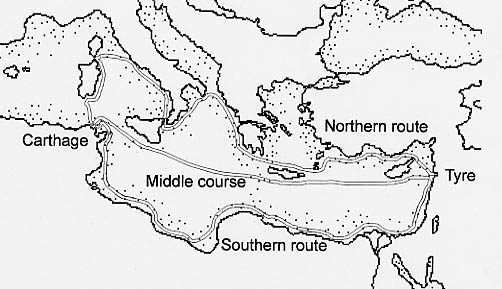| The
Mediterranean Sea
- a brief history Page 5 - |
The
Phoenicians
Persia’s propensity for trade was taken up by the Phoenicians, who lived on the Lebanese coast in the ancient cities of Biblos, Sidon and Tyre. Whereas the Egyptians kept more to themselves and traded predominantly up the Nile, the Phoenicians, with only a narrow strip of fertile coastal land to live on, could only look outwards for any hope of development and it was from here that Man commenced his navigation westwards, to conquer ever more territories.
Using
their large supply of fine cedar wood, the Phoenicians constructed boats strong enough to
face the Mediterranean Sea, which at first had represented a barrier, but now gave them
the possibility to travel westwards and to found new colonies. Their boats were driven
both by sail and by crews of oar-men and became progressively larger and larger.

1. Following
the Northern shores, through Turkey, Greece, Corfu, the heel of Italy, The Messina Strait,
the Italian coastline to Elba, then across to Corsica and Sardinia.
2. The
Southern course, following the North African coastline, always remaining within sight of
land and making land-fall at night time. Many a port on today’s maps represented one
day’s sailing from the next, for the ancient Phoenicians.
3. The
third route westwards was used later, by the more experienced sailors and with a more
refined sailing equipment, as it meant going straight out to sea, beyond sight of land.
From Tyre, they sailed to Cyprus, then to Crete, to Malta and arriving at Carthage,
travelling overnight and navigating by the stars.
Carthage
dominated the scene up until defeat by the Romans in around 200 BC.
They exported their highly-valued purple dye colored cloths, which were achieved from processing certain marine sea-shells and traded their fine glass-wares. They were also traders in wine, shipping it all the way from Lebanon, up until grape vines began to be cultivated locally. Their colonisation of Sardinia, dating from VIII Century BC, was mainly to acquire silver, copper and lead from the mines, which they traded with much profit.
The Mediterranean Sea
mediterranean-yachting.com
Copyright L. Camillo
2011